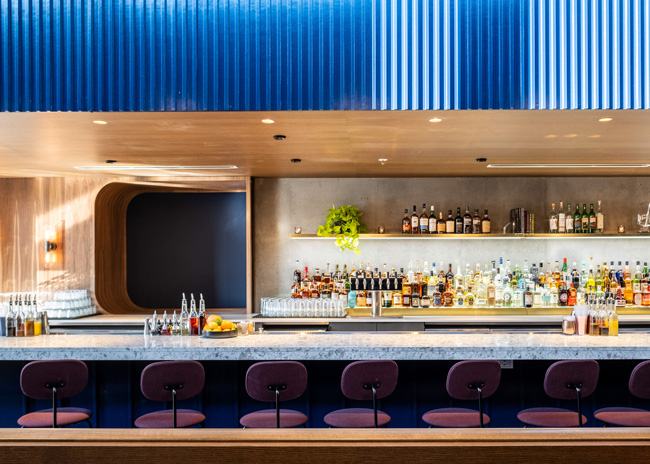The atmosphere of a foodservice operation directly impacts the diner’s experience. Along with aesthetics, the acoustics set the tone of the space. This also can directly affect service and the bottom line. If the servers cannot hear patrons, it can result in erroneous orders that lead to both an unhappy diner and food waste.
Most restaurant operators don’t want to dedicate floor, wall or ceiling space to acoustical treatments. The last thing an operator wants to spend money on is something that feel superfluous and doesn’t impact the food or enhance the aesthetics. However, survey after survey over the last decade has named noisy or loud restaurants as a top complaint of diners. Even restaurant designers find poor acoustics frustrating: 31% of readers of restaurant development + design noted that poor acoustics was their biggest design pet peeve in a survey fielded in February 2025.
Ideally, acoustical treatments should cover about 70% of the walls and ceiling, but this can be costly. The goal should be to integrate sound proofing and absorption materials seamlessly into the restaurant design, but because many locations are retrofits, this is not always possible. Fortunately, soundproofing aesthetics have improved and there are solutions.
Sounding Out
Acoustics rely on both physics and math since the size of the room determines what sound and noise issues need solving. Humans hear direct energy or straight line energy, which is sound from person to person. There are sound reflections in a room that confuse and distort that energy. The fix is to absorb enough of the energy in the reflection that it doesn’t interfere with direct energy.
No matter where the energy is coming from, whether a conversation or music, the height of the ceiling and square footage of the space are the primary factors in creating an acoustic solution. The number of diners also impacts what acoustic treatment solution is best.
The biggest sound issue in restaurants is reverberation or echo. This is the summation of all reflections off the walls, ceiling and floor. Every room has six surface areas, with each contributing 17% of the reverberation. It’s best to keep reverberation down to 1 or 1½ seconds, which is how long sounds stays in the room.
Noise Reduction Coefficient (NRC), Ceiling Attenuation Class (CAC) and Sound Transmission Class (STC) are laboratory measurements of material absorption. The higher the rating, the better the sound reduction. Noise Isolation Class (NIC) is a number rating using measured values of noise reduction. Sabin is the unit of measure for total sound absorption of an acoustical object.
Sound absorption technology can fix acoustical issues. This requires absorbing at least 75% of the frequency range from 125 to 500 hertz, which is the core frequency range of reverberation.
It’s important to incorporate a balance of acoustical treatments suitable for dining that are easily cleaned and maintained. Solutions typically require a layered approach that takes into account the overall balance of the space.
It’s important to determine where sound is coming from and what can capture the sound from a 360-degree perspective.
The current laws of physics require at least 6-inch panels on walls and ceilings, which will provide proper sound absorption. With acoustic solutions, each wall should be treated as if it’s a separate room.
Acoustic Materials
The most economical treatment is fabric-wrapped foam panels, which can be easily cut in various shapes and sizes for wall hanging. These offer various thicknesses, colors and fabric types as well as image transfer capabilities. Fiberglass panels are popular and customizable, as well.
Panels can also be filled with denim, cotton or fiber. For those not wanting to hang panels, dense drapery in six to eight layers provides the same effect as 2 inches of foam.
PET felt is decorative, available in multiple colors and shapes and can be used in a wide variety of acoustical applications. When used with additional insulation, dry wall and plaster are sound control options that provide a finished look and durability in new builds. Vinyl with a leather-like appearance is another acoustical treatment option.
Because many perimeter walls in restaurants are glass, which doesn’t absorb sound, it’s common to treat the area above windows with sound-absorbing material.
Sound is better absorbed on the ceiling than the floors. Hanging baffles and clouds are commonly used for this as well as acoustic wood products that may be perforated. Other options include spray insulation on ceiling slabs or panels. Today operators can get the look of a wood paneled ceiling with micro perforation products.
Exposed ceilings with an industrial appearance are on trend, but can lead to more noise. In this case, vertical baffles provide a better NRC rating and sound control. Acoustical panels positioned between joists and wooden ceilings with gaps also help trap noise.
There are other solutions that are low tech to decrease sound, such as dampeners under chair legs that dull noise when seating is moved and trash cans with casters for the same effect.
Fortunately, acoustic treatments have become easier to install because materials are lighter than in the past. There are also more color, shape and style options. In addition, acoustic solution manufacturers have paid more attention to sound and decibels.
When choosing an acoustic treatment solution, working with an AV consultant is critical to ensure all aspects are taken into consideration.
Common Mistakes
There are several important factors that should be looked at when considering what acoustic treatment solution is best for an operation. These include:
- Making sure the design team assists with the acoustic conversation in the initial design phase. Baffles hung after the fact are a sign that the conversation didn’t take place soon enough in the design process.
- Consider certain sounds that are part of the brand identity.
- Be aware of the layout from the get-go before choosing a solution.
- Look at the louder components of service and how seating zones can be created. Consider back of house noise, such as dishwashers, along with restroom noises.
- The menu, kitchen equipment, number of employees and overall energy of the space will impact acoustical treatment needs.
- Architectural calculators factor in the amount of untreated reverberation time at different decibels using space dimensions and finished surfaces. This provides better insight into what acoustical treatments are needed. It also will determine the amount of materials needed and how it should be disbursed throughout the space.
- Most building codes mandate the use of fire-resistant acoustic materials. The Class A fire rating means that the acoustic wall treatment received the highest rating possible under the ASTM E-84, a test that measures the burning characteristics of building materials.
- One of the most common mistakes is underordering acoustical material for the rate, level of absorption and surface area coverage needed. If 30 square feet of treatment is used on one wall, then 30 square feet will be needed on another to balance the sound level.



